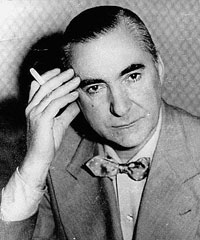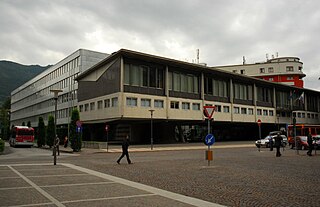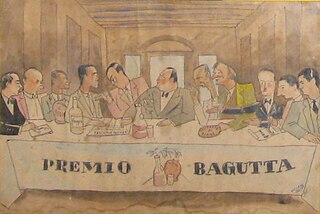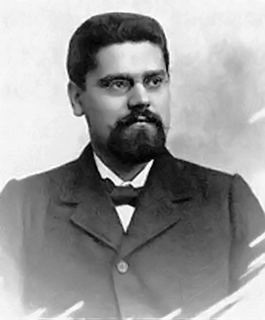Related Research Articles

Giuseppe Ungaretti was an Italian modernist poet, journalist, essayist, critic, academic, and recipient of the inaugural 1970 Neustadt International Prize for Literature. A leading representative of the experimental trend known as Ermetismo ("Hermeticism"), he was one of the most prominent contributors to 20th century Italian literature. Influenced by symbolism, he was briefly aligned with futurism. Like many futurists, he took an irredentist position during World War I. Ungaretti debuted as a poet while fighting in the trenches, publishing one of his best-known pieces, L'allegria.

Curzio Malaparte, born Kurt Erich Suckert, was an Italian writer, filmmaker, war correspondent and diplomat. Malaparte is best known outside Italy due to his works Kaputt (1944) and La pelle (1949). The former is a semi-fictionalised account of the Eastern Front during the Second World War and the latter is an account focusing on morality in the immediate post-war period of Naples.

Adalberto Libera is one of the most representative architects of the Italian Modern movement.

The Bagutta Prize is an Italian literary prize that is awarded annually to Italian writers. The prize originated among patrons of Milan's Bagutta Ristorante. The writer Riccardo Bacchelli discovered the restaurant and soon he regularly gathered numerous friends who would dine there together and discuss books. They began charging fines to the person who arrived last to an appointed meal, or who failed to appear.
Giuseppe Prezzolini was an Italian literary critic, journalist, editor and writer. He later became an American citizen.

The "Manifesto of Fascist Intellectuals", by the actualist philosopher Giovanni Gentile in 1925, formally established the political and ideologic foundations of Italian Fascism. It justifies the political violence of the Blackshirt paramilitaries of the National Fascist Party, in the revolutionary realisation of Italian Fascism as the authoritarian and totalitarian rėgime of Prime Minister Benito Mussolini, who ruled Italy as Il Duce, from 1922 to 1943.

Giacomo Debenedetti was an Italian writer, essayist and literary critic. He was one of the greatest interpreters of literary criticism in Italy in the 20th century, one of the first to embrace the lessons of psychoanalysis and the human sciences in general, and among the first to grasp the full extent of Marcel Proust's genius.

Giovanni Battista Angioletti was an Italian writer and journalist.
Umberto Barbaro was an Italian film critic and essayist.

Scuola romana or Scuola di via Cavour was a 20th-century art movement defined by a group of painters within Expressionism and active in Rome between 1928 and 1945, and with a second phase in the mid-1950s.
Meridiano di Roma: literary, artistic and scientific Italy was a literary criticism, literature and art magazine existed between 1936 and 1943.

Eurialo De Michelis was an Italian writer, poet and literary critic born in Salerno in Mezzogiorno.
Enrico Falqui was an Italian writer and literary critic.
Emilio Cecchi was an Italian literary critic, art critic and screenwriter. One English language source describes him as "an 'official' - although radically anti-academic - intellectual".

Omero Vecchi, known by his pen name Luciano Folgore, was an Italian poet.
Critica fascista was a biweekly cultural magazine which was founded and edited by Giuseppe Bottai in Rome, Italy. The magazine existed during the Fascist rule in the country from 1923 to 1943.
Umberto Fracchia was an Italian writer who died young. He was intensely active professionally for slightly more than two decades, between 1908 and 1930. He began writing short stories at an early age, but built his career initially as a journalist and literary critic. During 1919/20 he broke into the movie business, directing several films in quick succession, before his professional focus returned abruptly to writing. Over the next decade, in parallel with his journalistic work, he published a succession of novels and short stories which achieved significant commercial success. He also, in 1925, launched La Fiera Letteraria, a broadly-based literary magazine which he ran successfully for a couple of years with a skeleton staff consisting principally of himself and his wife. Exhausted by the intensity of the work and the political pressure to which magazine publishers were subjected at the time, in 1928 he transferred management of the publication to Giovanni Battista Angioletti and Curzio Malaparte while, at this stage, retaining his financial interest in it. After his sudden death from heart disease at the end of 1930, Fracchia's work remained widely read in and beyond Italy for a number of years.
References
- ↑ Letteratura, Rai. "Spazi900: nuovo allestimento alla Biblioteca Nazionale Centrale di Roma". Il portale sulla letteratura di Rai Cultura (in Italian). Retrieved 24 November 2017.
- ↑ ""La Guidacci è dramma e allegoria"" (in Italian). Retrieved 24 November 2017.
- ↑ Irene Bartalena (2009). "La Fiera letteraria" negli anni 1949 e 1950: erudizione oltre l'"impegno" (in Italian). Rome: Aracne. ISBN 9788854825970.
- ↑ La Fiera letteraria (in Italian). Società italiana pubblicità per azioni. 1975.